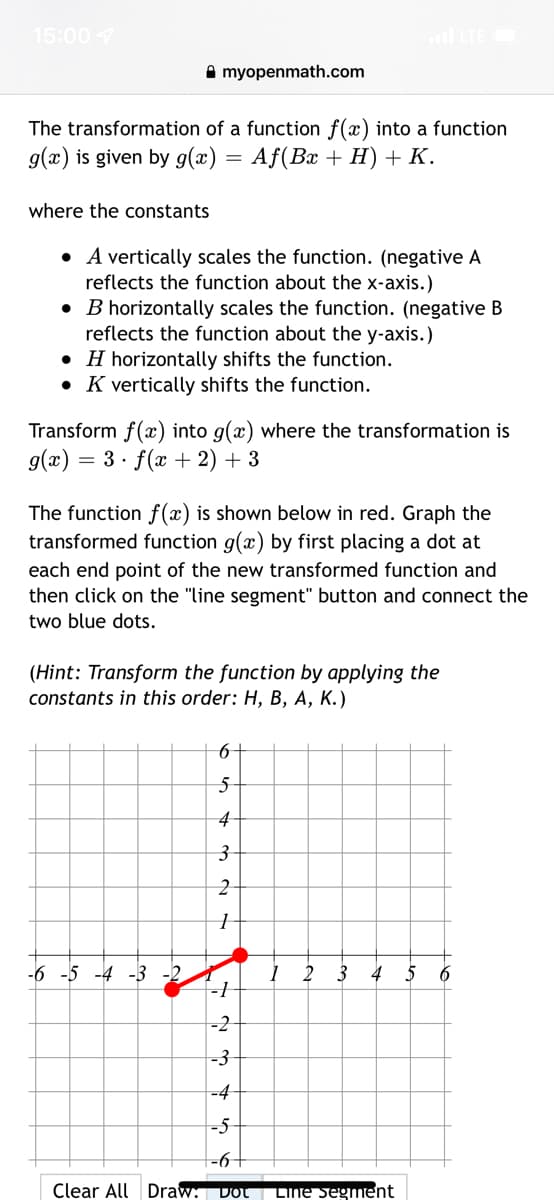The transformation of a function f(x) into a function g(x) is given by g(æ) = Af(Bx + H) + K. where the constants • A vertically scales the function. (negative A reflects the function about the x-axis.) • B horizontally scales the function. (negative B reflects the function about the y-axis.) • H horizontally shifts the function. • K vertically shifts the function. Transform f(x) into g(x) where the transformation is g(æ) = 3 f(x + 2) + 3 The function f(x) is shown below in red. Graph the transformed function g(x) by first placing a dot at each end point of the new transformed function and then click on the "line segment" button and connect the two blue dots. (Hint: Transform the function by applying the constants in this order: H, B, A, K.) 4 -6 -5 -4 -3 -2 1 2 3 4 5 6 -2
The transformation of a function f(x) into a function g(x) is given by g(æ) = Af(Bx + H) + K. where the constants • A vertically scales the function. (negative A reflects the function about the x-axis.) • B horizontally scales the function. (negative B reflects the function about the y-axis.) • H horizontally shifts the function. • K vertically shifts the function. Transform f(x) into g(x) where the transformation is g(æ) = 3 f(x + 2) + 3 The function f(x) is shown below in red. Graph the transformed function g(x) by first placing a dot at each end point of the new transformed function and then click on the "line segment" button and connect the two blue dots. (Hint: Transform the function by applying the constants in this order: H, B, A, K.) 4 -6 -5 -4 -3 -2 1 2 3 4 5 6 -2
Algebra & Trigonometry with Analytic Geometry
13th Edition
ISBN:9781133382119
Author:Swokowski
Publisher:Swokowski
Chapter2: Equations And Inequalities
Section2.7: More On Inequalities
Problem 44E
Related questions
Question
100%

Transcribed Image Text:15:00 7
l LTE
A myopenmath.com
The transformation of a function f(x) into a function
g(x) is given by g(x) :
Af(Bx + H) + K.
where the constants
• A vertically scales the function. (negative A
reflects the function about the x-axis.)
• B horizontally scales the function. (negative B
reflects the function about the y-axis.)
• H horizontally shifts the function.
• K vertically shifts the function.
Transform f(x) into g(x) where the transformation is
g(x) = 3 · f(x + 2) + 3
The function f(x) is shown below in red. Graph the
transformed function g(x) by first placing a dot at
each end point of the new transformed function and
then click on the "line segment" button and connect the
two blue dots.
(Hint: Transform the function by applying the
constants in this order: H, B, A, K.)
5-
4
3
2-
-6 -5 -4 -3 -2.
--
3
4 5 6
-2
-3
-4
-5-
-6-
Clear All Draw: Dot LIne Segment
Expert Solution
This question has been solved!
Explore an expertly crafted, step-by-step solution for a thorough understanding of key concepts.
This is a popular solution!
Trending now
This is a popular solution!
Step by step
Solved in 3 steps with 2 images

Recommended textbooks for you

Algebra & Trigonometry with Analytic Geometry
Algebra
ISBN:
9781133382119
Author:
Swokowski
Publisher:
Cengage

Trigonometry (MindTap Course List)
Trigonometry
ISBN:
9781337278461
Author:
Ron Larson
Publisher:
Cengage Learning

Algebra & Trigonometry with Analytic Geometry
Algebra
ISBN:
9781133382119
Author:
Swokowski
Publisher:
Cengage

Trigonometry (MindTap Course List)
Trigonometry
ISBN:
9781337278461
Author:
Ron Larson
Publisher:
Cengage Learning